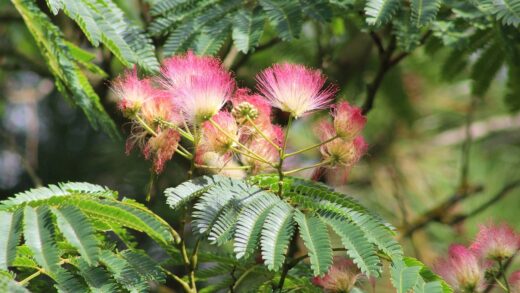While the clustered tulip is a relatively robust and resilient species, it is not entirely immune to the various diseases and pests that can affect tulip plantings. Being aware of the potential threats and knowing how to identify them early is crucial for maintaining a healthy and vibrant display. Most problems can be prevented or managed effectively through good cultural practices, such as ensuring proper planting depth, excellent soil drainage, and adequate air circulation. A proactive approach, focusing on creating a healthy growing environment, is always more effective than reacting to a problem once it has taken hold and caused significant damage.
The most significant disease threat to all tulips, including Tulipa praestans, is tulip fire, a fungal disease caused by Botrytis tulipae. This disease can affect all parts of the plant and is most prevalent in cool, damp spring weather. Symptoms include distorted and twisted leaf growth, brown spots or ‘scorched’ patches on the leaves and petals, and a grey, fuzzy mould that can appear on infected tissues. In severe cases, the entire plant can collapse. Prevention is key and involves planting only healthy, firm bulbs, providing good spacing for air circulation, and avoiding overhead watering.
Another potential issue is bulb rot, which is not a single disease but rather a general term for the decay of the bulb caused by various soil-borne fungi or bacteria. The primary cause of bulb rot is almost always poor drainage and waterlogged soil conditions. Bulbs that sit in wet soil are deprived of oxygen and become highly susceptible to attack from pathogens like Fusarium or Pythium. The only outward symptom may be the failure of the plant to emerge in the spring or stunted, yellowing growth that quickly dies. The best and only real defence against bulb rot is to ensure the planting site has exceptionally sharp drainage.
On the pest front, aphids are one of the most common culprits. These small, sap-sucking insects often colonize the tender new growth and undersides of leaves. While a small infestation is unlikely to cause major harm, large populations can weaken the plant and cause distorted growth. More significantly, aphids are notorious vectors for spreading viruses between plants. Tulip breaking virus, for example, which causes dramatic but damaging streaks and stripes in the flower petals, is transmitted by aphids. Monitoring for and controlling aphid populations early can help to prevent the spread of these incurable viral diseases.
Slugs and snails can also be a nuisance, particularly in damp climates. These molluscs are fond of the tender leaves and petals of tulips, and they can cause significant damage by chewing ragged holes in the foliage and flowers, especially as they emerge in the spring. Their feeding can disfigure the plants and, in the case of young shoots, can destroy the plant entirely. Various control methods, from physical barriers and traps to organic slug pellets, can be employed to protect the plants from these voracious pests, especially during the vulnerable early stages of growth.
More articles on this topic
Common fungal diseases
Fungal diseases represent the most common and serious threat to the health of clustered tulips, with tulip fire (Botrytis tulipae) being the most infamous. This disease thrives in the cool, wet conditions typical of spring. The first signs are often small, water-soaked spots on the leaves that quickly enlarge into brown, necrotic lesions with a scorched appearance, giving the disease its name. The growth of emerging shoots can be severely distorted and stunted, sometimes failing to emerge from the soil at all. Flowers may be spotted and fail to open properly, and in humid weather, a characteristic fuzzy grey mould will develop on the infected tissues.
Prevention of tulip fire begins with sourcing and planting only high-quality, healthy bulbs that are firm and free from blemishes or signs of mould. The fungus can survive in the soil and on infected plant debris, so good garden hygiene is paramount. Remove and destroy any infected plants as soon as they are noticed to prevent the spread of fungal spores. Do not compost infected material. After an outbreak, it is advisable to rotate your tulip planting to a different location for a few years. Providing adequate spacing between bulbs to promote good air circulation can also help the foliage to dry more quickly, creating a less favourable environment for the fungus.
Bulb rot is another major fungal issue, primarily caused by Fusarium oxysporum or other soil-borne pathogens. This disease attacks the bulb itself, usually at the basal plate where the roots emerge. The infection is greatly exacerbated by poor drainage and warm soil temperatures. Above ground, the symptoms can include stunted growth, yellowing leaves, and premature death of the plant. If you dig up an affected bulb, you will find it to be soft, rotted, and often covered in a white or pinkish mould. There is no cure for bulb rot once a bulb is infected.
The key to preventing bulb rot lies entirely in cultural practices. The most important factor is providing excellent drainage. Amending heavy soils with grit and organic matter or using raised beds is essential. Avoid overwatering, especially during the summer dormant period when the bulbs are particularly vulnerable. When purchasing bulbs, inspect them carefully and discard any that feel soft or show signs of mould or decay. Proper handling is also important; avoid bruising or damaging the bulbs during planting, as wounds can provide an entry point for fungal pathogens.
More articles on this topic
Viral infections in tulips
Viral diseases can also affect clustered tulips, and while they may not always kill the plant outright, they can weaken it significantly and cause unsightly symptoms. The most historically famous is the Tulip Breaking Virus, which causes the dramatic and beautiful colour streaks and flame patterns seen in famous Rembrandt tulips of the 17th century. However, this ‘breaking’ is a symptom of a disease that weakens the bulb, reduces its vigour, and leads to its eventual decline. Other symptoms of viral infections can include distorted growth of leaves and flowers, and unusual mottling or striping on the foliage.
Unlike fungal diseases, there is no chemical cure for a plant virus. Once a tulip bulb is infected with a virus, it is infected for life and will remain a source of infection for other nearby tulips. Therefore, management of viral diseases is focused entirely on prevention and control. The primary goal is to stop the spread of the virus from one plant to another. Any plant that shows clear symptoms of a viral infection, such as colour breaking in the flowers or significant mottling on the leaves, should be dug up and destroyed immediately.
The main vectors for the spread of tulip viruses are sap-sucking insects, most notably aphids. As an aphid feeds on an infected plant, it picks up virus particles in its mouthparts and can then transmit them to the next healthy plant it feeds on. Consequently, controlling aphid populations is a critical step in preventing the spread of viral diseases in your tulip collection. Regularly inspect your plants for aphids, especially on new growth, and take action at the first sign of an infestation. This can be as simple as spraying them off with a strong jet of water or using an insecticidal soap.
Good hygiene and tool sanitation are also important in preventing the mechanical spread of viruses. While less common than insect transmission, some viruses can be spread on tools like knives or pruners that have been used on an infected plant. When deadheading or cutting flowers, it is a good practice to disinfect your tools between plants, especially if you suspect a virus might be present. This can be done by wiping the blades with rubbing alcohol or a disinfectant solution.
Managing common pests
Several pests can cause problems for clustered tulips, with aphids being among the most frequent. These small, soft-bodied insects use their piercing mouthparts to suck sap from the tender parts of the plant, such as new leaves, stems, and flower buds. A heavy infestation can cause the leaves to curl and become distorted, and can weaken the overall plant. Their most significant threat, however, is their role as vectors of incurable viral diseases. Early detection and control are therefore very important. A strong spray of water from a hose can dislodge small populations, while insecticidal soaps or neem oil can be used for more persistent infestations.
Slugs and snails pose a significant threat, especially during the damp weather of early spring when the tulip shoots are just emerging. These molluscs can devour young shoots entirely, preventing them from ever flowering. They also chew ragged holes in more mature leaves and can climb the stems to damage the flowers. There are numerous methods to control them. Creating barriers of coarse sand, crushed eggshells, or copper tape around the planting area can deter them. Beer traps, where slugs and snails are attracted to a container of beer and drown, can be effective. In cases of severe infestation, organic ferric phosphate-based slug pellets can be used.
Another pest to be aware of is the lily beetle (Lilioceris lilii), and while its primary host is the lily, it is known to feed on other members of the lily family, including tulips. The adult beetles are bright scarlet red and are easily spotted. Both the adults and their unpleasant-looking, black-frass-covered larvae feed on the leaves, stems, and flowers, and can cause rapid and extensive damage. The most effective control method in a garden setting is to regularly inspect the plants and hand-pick the adults and larvae, dropping them into a bucket of soapy water.
Less common, but still a potential threat, are rodents like mice, voles, and squirrels. These animals can be a problem in the autumn and winter when they dig up and eat the newly planted bulbs. If you have a known problem with rodents in your garden, you can take preventative measures. Planting the bulbs a little deeper can sometimes help. You can also protect the bulbs by lining the planting hole or covering the planting bed with a wire mesh or hardware cloth. This creates a physical barrier that the rodents cannot easily chew through to get to the bulbs.
Preventative strategies and good husbandry
The most effective approach to managing pests and diseases in clustered tulips is to focus on prevention through good cultural practices. Creating a healthy, stress-free environment for your plants is the best defence, as strong, vigorous plants are inherently more resistant to problems. This begins with the very first step: planting healthy, high-quality bulbs from a reputable source. Inspect all bulbs before planting and discard any that are soft, mouldy, or damaged, as these can introduce diseases into your garden soil.
Site selection and soil preparation are paramount. As has been repeatedly emphasized, tulips demand excellent drainage. Planting in heavy, waterlogged soil is the primary cause of bulb rot and creates a stressful environment that weakens the plant’s natural defences. Choose a sunny location and take the time to amend the soil with organic matter and grit to ensure water can drain away freely. Proper spacing of bulbs is also a key preventative measure. Good air circulation around the plants allows the foliage to dry quickly after rain or dew, which significantly reduces the incidence of fungal diseases like tulip fire that thrive in damp conditions.
Good garden hygiene throughout the year plays a crucial role in disease prevention. In the autumn, ensure you clean up and remove all old plant debris from the tulip bed, as fungal spores can overwinter in this material. During the growing season, promptly remove any leaves or plants that show signs of disease. After flowering, deadhead the spent blooms to prevent them from rotting and potentially harbouring fungal spores. Always use clean tools when working with your plants to avoid spreading pathogens.
Finally, a balanced approach to watering and fertilizing contributes to overall plant health. Avoid over-fertilizing with high-nitrogen feeds, which produces soft, susceptible growth. Stick to a feeding regime that supports bulb health with phosphorus and potassium. Water appropriately for the season, providing moisture during spring growth and ensuring a dry dormant period in summer. By combining these practices of good husbandry, you create a garden ecosystem where your clustered tulips can thrive and are much less likely to succumb to pests and diseases.


















